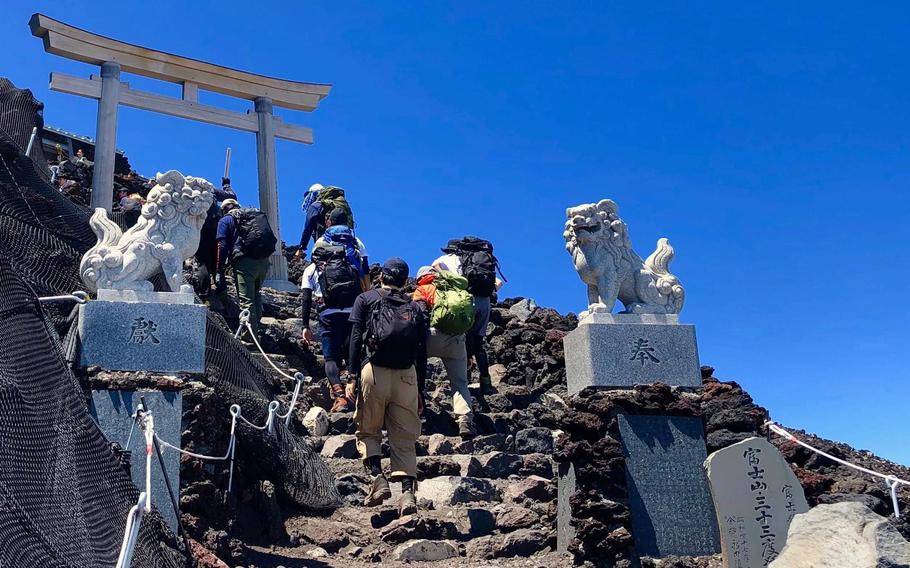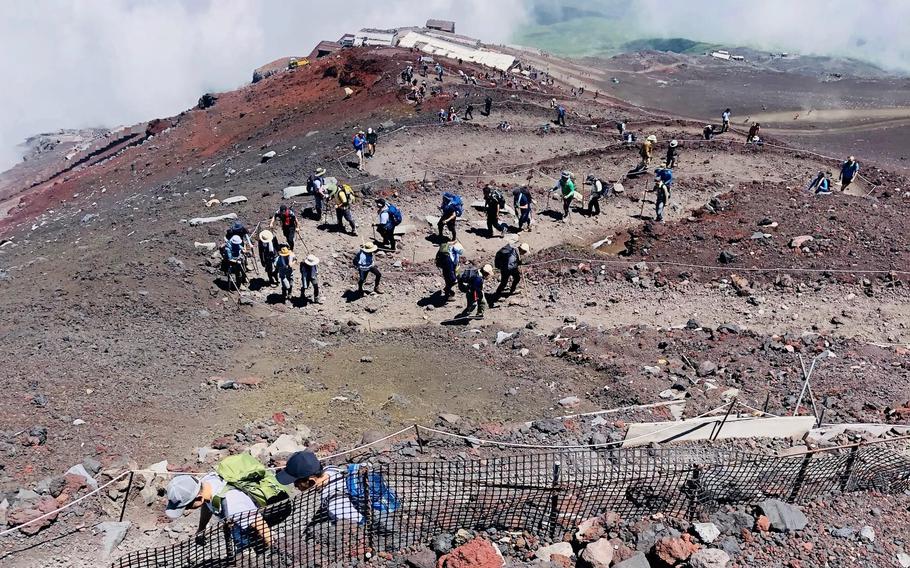
Hikers on the Yoshida Trail approach the torii that signals they’ve reached the summit of Mount Fuji, Japan, in August 2019. (Joseph Ditzler/Stars and Stripes)
Climbing Mount Fuji on a trip sponsored by a U.S. military base will cost more this year as Japan seeks to offset the impact of thousands of visitors to the iconic volcano.
Yamanashi prefecture this summer is charging a new, 2,000-yen hiking fee, or $12.46, a prefectural spokesman told Stars and Stripes by phone Tuesday.
“The money will go to any fee needed to regulate visitors, as well as for safety measures,” the spokesman said.
The prefecture also installed a gate, a crowd-control measure, at the Yoshida Trail at the mountain’s 5th Station, where tour buses park and many hikers begin their trek to the 12,390-foot summit.
About 60% of all Mount Fuji climbers take the Yoshida Trail, according to a Japan Times report May 4. No fee is charged at the Subashiri, Gotemba or Fujinomiya trails on the Shizuouka prefecture side of the mountain.
Climbing season begins Monday in Yamanashi and July 10 in Shizuoka and ends in early September.
Along with the new fee, Yamanashi prefecture will limit the number of hikers on the Yoshida Trail to 4,000 daily and close the 5th Station gate from 4 p.m. to 3 a.m., except for individuals with mountain hut reservations getting to the mountain late, the spokesman said.
“The regulation aims to prevent exceeding congestion near the summit and prevent so-called ‘bullet climbing,’ ” the spokesman said. Bullet climbers ascend Fuji at night, catch sunrise at the summit and descend without taking a rest.
The spokesman said visitors may make reservations online through the prefecture’s website for the Yoshida gate. Hikers without reservations may pass through the gate until the number reaches 4,000.
Government spokespeople in Japan are often required to speak to the media only on condition of anonymity.

Hikers thread their way along the Yoshida Trail on Mount Fuji, Japan, in August 2019. (Joseph Ditzler/Stars and Stripes)
Local authorities have voiced concern over overcrowding trails on Mount Fuji, the spokesman said. A falling climber could cause domino toppling and lead to a major accident, he said.
Thousands of people of all ages safely ascend the mountain every day, but the journey is not without risk. Authorities found the bodies of three missing climbers inside the crater atop Mount Fuji on Wednesday, according to a report Thursday in Japan Today.
The same day, a professional climber in his 50s, Keita Kurakami, lost consciousness around 10,000 feet on the Yoshida Trail and later died in a local hospital, according to the report.
Groups with outdoor recreation programs at bases in the Tokyo area typically hike the Yoshida Trail to the summit, Yoshimasa Nakamura, recreation specialist at Yokota Air Base, told Stars and Stripes on Tuesday.
Yokota Outdoor Recreation is adding $20 to its Mount Fuji day hikes, for a total $90, Nakamura said. There is no change to the number of hikers the trip can accommodate, he said.
The next trip from Yokosuka Naval Base to Mount Fuji is July 13, with room on the bus for 32 hikers, Hiroyuki Yoneda, a recreation aide with Morale, Welfare and Recreation, told Stars and Stripes by phone Tuesday.
The trip with the extra fee costs $87 dollars, which has not deterred customers from signing up, Yoneda said.
At Camp Zama, the outdoor recreation program is not adding the hiker’s fee to its trips or reducing its planned hikes, but hikers must pay the additional 2,000 yen on their own at the trailhead, Miho Overly, program assistant at Zama’s MWR program told Stars and Stripes by phone Tuesday.
At Yokota, Nakamura said he hopes the added cost will not deter people from hiking Mount Fuji. As a guide at Yokota, Nakamura has climbed the mountain more than 100 times, with as many as 30 hikers at once.
“I like the feeling of reaching the summit,” he said. “When all the fatigue is gone, you’re at the top and you have the feeling of comfort.”